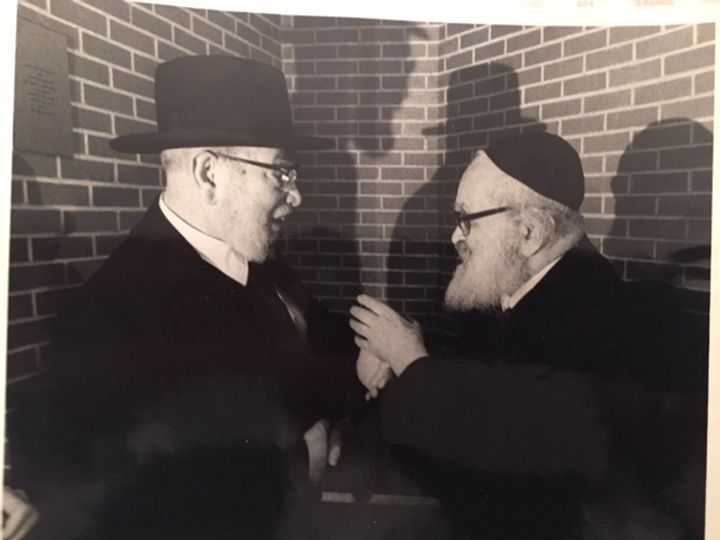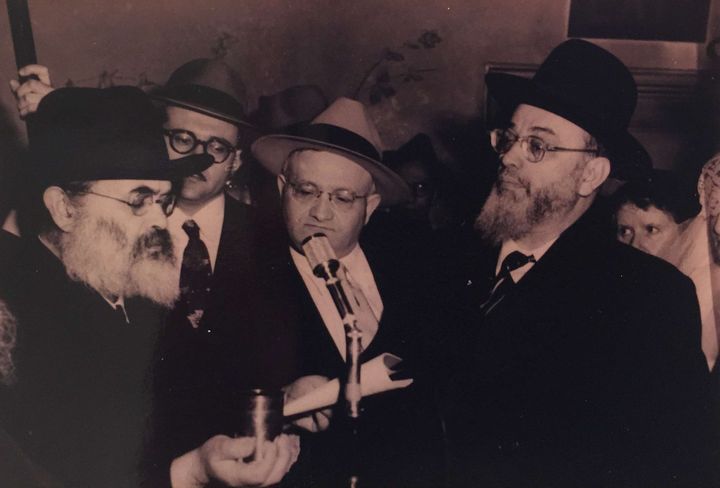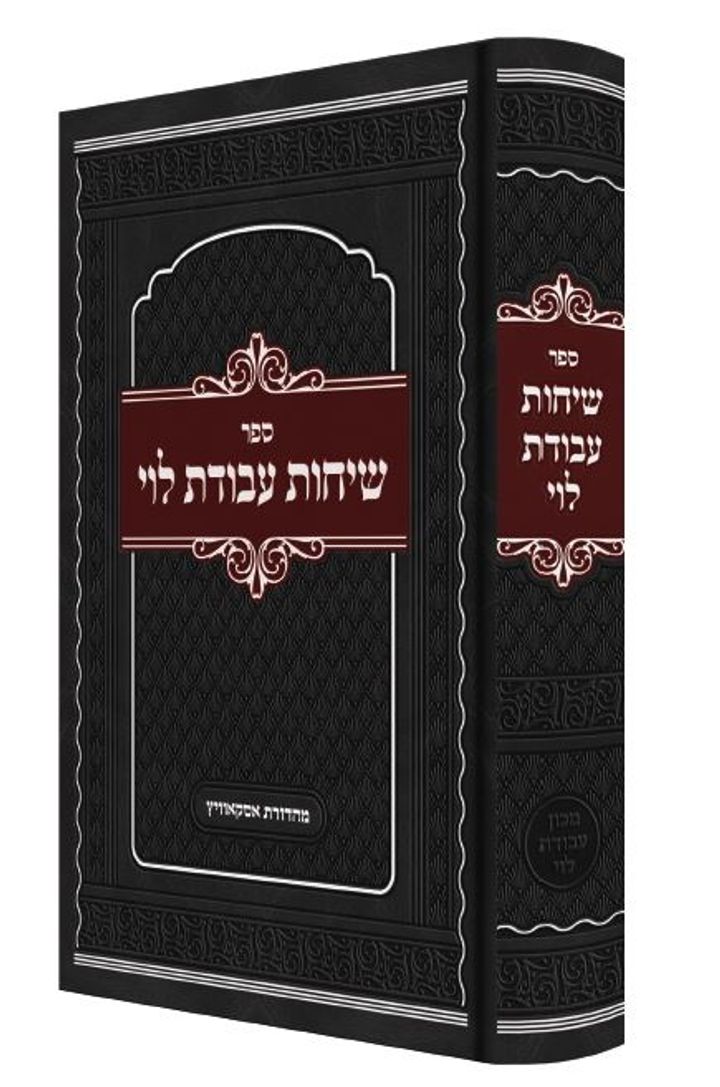Sichos Avodas Levi By Rav Yaakov Yitzchok Ruderman, ZT'L, Reviewed by Rabbi BZ Karman
“Rav Ruderman is the talmid whose character and actions are most similar to those of the Alter [of Slobodka]” (Rav Yaakov Kamenetsky, zt”l)

Maran Rosh HaYeshiva, HaRav Ruderman, ZT'L, with Reb Yaakov Kaminetsky, ZT'L, at the Chag HaYovel in 1983.
Rav Nosson Tzvi Finkel, better known as the Alter of Slobodka, had a shitah in which he fostered and nurtured each talmid to progress according to his individual natural tendency. Thus, if we study his talmidim, we find that although they all share a common reverence for their rebbi, nevertheless each one developed their own unique traits, which were not necessarily a carbon copy of the Alter. Yet in the opinion of Rav Yaakov Kamenetsky, his cousin, Rav Ruderman, was the most similar to their master.
Upon his arrival in the Slobodka Yeshiva at the outbreak of WWI, the yeshiva was fleeing the battlegrounds to resettle in Minsk. The Alter, who recognized the young prodigy’s capabilities, was worried about the negative influence that a certain roommate may have on him, and took him in to his own home, caring for him as a father for a son. Thus, Rav Ruderman’s growth and success were a direct product of the direction he received from the Alter. In addition to this relationship, Rav Ruderman studied under Rav Moshe Mordechai Epstein, the rosh yeshiva of Slobodka, who saved his life when he was taken prisoner by marauding soldiers.
In Minsk, Rav Ruderman had many opportunities to interact with some of the Torah leaders of the previous generation, including Rav Raphael Shapiro of Volozhin, Rav Chaim Soloveichik of Brisk, and Rav Eliezer Rabinowitz of Minsk. In addition, he spent some time with Rav Chaim Ozer Grodzinsky, as well as with the Chofetz Chaim, where he was inspired by their greatness in Torah. When he met Rav Yosef Leib Bloch of Telz at a retreat, they spent their days strolling in the surrounding forests, all the while discussing Torah topics and his outlook on life. Rav Leib Rubin of Wilkomir (the father in law of Rav Yosef Shlomo Kahaneman of Ponovez) exchanged letters with him, some of which Rav Ruderman printed in his Sefer Avodas Levi. These experiences had a dramatic effect on him, and Rav Ruderman would often describe the gedolim he had met or heard about, speaking of the lessons he learned and guidance he gained from these illustrious personalities.
In 5684/1924, he married Feiga, the daughter of Rav Sheftel Kramer, one of the Ramim in Slutzk. Rav Sheftel was a son in law of the legendary Reb Shraga Feivil Frank, one of the confidants of Rav Yisroel Salanter, who merited having sons in law, in addition to Rav Sheftel, who led the Yeshiva world: Rav Issur Zalman Meltzer, Rav Moshe Mordechai Epstein, and Rav Baruch Yehoshua Horowitz. After his marriage, Rav Ruderman learned in the Kovna Kollel, under the leadership of Rav Avrohom Duber Kahane-Shapira (Dvar Avrohom), from whom he learned psak halchah as well as public guidance. At the urging of the Kovna Rav, in 5790/1930 he printed Avodas Levi, a compendium of some of his chiddushim, which was graced with the haskamos of the Dvar Avrohom and Rav Moshe Mordechai Epstein.

Maran Rosh HaYeshiva, HaRav Ruderman, ZT'L, at a Chasuna in the 1950's, with Reb Yaakov Kaminetsky, ZT'L
Rav Sheftel Kramer, who had moved to America, urged his son in law to join him in educating the youth of America to grow in Torah. After completing his five-year stint in the Kovna Kollel, Rav Ruderman immigrated to Cleveland, and began over a half century of harbatzas Torah on these shores. After Succos of 5794/1934, Rav Ruderman founded his yeshiva in Baltimore, which he named Ner Yisroel after Rav Yisroel Salanter. In a relatively short period of time, the yeshiva added many talmidim, which numbered thirty in three years, and doubled to sixty in another two years.
Ever the talmid of the Alter, Rav Ruderman not only showed paternal care for his talmidim, but was also concerned to uplift the prominence of Torah learning and scholarship. To this end, he exhorted his talmidim to carry themselves pleasantly as befitting the princes of Torah, and took care that the structure of the yeshiva be immaculate as well. He challenged his students to reach for the greatest heights in their learning, revealing his own greatness as a means of spurring them to attain the loftiest goals.
Perhaps the clearest display of his fidelity to the Slobodka principles was the manner in which he nurtured each talmid according to his own individual natural inclination. As a person who encompassed such broad Torah knowledge, he was capable of being a role model for talmidim with disparate natures, teaching them to examine all sides of issues.
In his sichos mussar, Rav Ruderman stressed that his goal was not to express a new vort, but rather to inspire improvement and advancement. “At times, people meet me and mention they remember a vort I said long ago, yet they have not changed from then until now. Through this, they show that they have neglected the key and seized upon the marginal. Even if they are not in agreement on the vort, it does not detract from the shmuez, which is designed to convey the mussar concept and bring about advancement. I remember how Rav Moshe Mordechai would review last year’s shmuez. Although he was a great innovator, and certainly had new ideas since last year, nevertheless this was not the goal of the shmuez.”
The first edition of Rav Ruderman’s shmuezen were printed in 5755/1995 by Rav Avrohom Reuven Askowitz, z”l, who wrote what he heard during the years 5733/1973 through 5737/1977, and prepared them for print. Rav Askowitz reviewed his writings with his colleagues, and Rav Ruderman expressed his pleasure with them when they passed before his eyes. Over the past years, he worked on them further, refining them once again in anticipation of reprinting them.
Several years ago, Machon Avodas Levi was established to publish Rav Ruderman’s writings, and had to date has published his chiddushim on several masechtos, while working to complete the publication of the rest of his chiddushim. In conjunction with the rosh yeshiva’s thirtieth yahrtzeit, Rav Askowitz graciously shared his work on the sichos with the Machon for publication. Additional material was added from tape recordings as well as from other writings of additional talmidim. Many new simanim containing sichos on the moadim were added for this edition. A brief biography as well as a detailed index is included.
Although the original publication followed the speaking style of Rav Ruderman, the current release was re-edited for ease of understanding, so that a wider audience, unfamiliar with his speaking style, could benefit from the sichos. The final product, which includes over four hundred and thirty pages and one hundred and seventeen sichos, is sure to be accepted as a classic sefer by the olam haTorah.
A central theme of Slobodka mussar is the emphasis placed on hakaras hatov, recognizing and expressing the good that others perform for you. In Parshas Va’eira, Rashi tells us that Moshe Rabeinu was told to command Aharon to initiate the first three plagues, since Moshe had benefited from the Nile River when his mother placed him there in his basket during his infancy, and from the sand which hid the Mitzri he killed. Indeed, although the river and sand were inanimate objects, Moshe was still proscribed from causing them harm. The Shitah Mekubetzes in Bava Kama (92b) quotes the R”i MiGash as stating that his rebbi, the Rif, refrained from ruling on a case involving a bathhouse since he had personally benefitted from it in the past when he was ill. From these and other sources, Sichos Avodas Levi shows the importance the Torah places on hakaras hatov. By acknowledging the good done by others, even if it is inanimate, one internalizes this trait within his very being.
Yet it behooves us to understand just why this middah is granted such meaning. Rav Ruderman quotes the Pesikta Zuta (Shmos 1:8) which tells us, “Whoever denies the good performed by his friend will eventually deny the good done by Hashem.” A central premise of our avodas Hashem is recognizing and acknowledging the good bestowed upon us from above. For this reason, we are directed to reinforce this concept by constantly strengthening our hakaras hatov in any manner we can.
To illustrate this, Sichos Avodas Levi brings a story told of the Chofetz Chaim who extended himself to help a certain new talmid get settled in his yeshiva in Radin. In reply to the question as to why he got so personally involved with this particular talmid, the Chofetz Chaim responded, “I was once staying in Vilna, and the grandfather of this talmid honored me to a great degree.”
Rav Ruderman goes on to explain that the yetzer hara often tries to prevent one from feeling or expressing gratitude for another person’s favors by planting negative thoughts about the benefactor in the mind of the recipient. He told of a time when the Chasam Sofer was terribly harassed by someone, and wondered, “What favor did I ever do for him that he is hounding me to this extent?”
This shmuez reminded me of an incident in the life of Rav Ruderman recorded in the biography in the preface of the sefer. A local doctor, who had long left the Torah camp, nevertheless maintained a feeling of reverence for the talmidei ha’yeshiva and continued to treat them gratis. Although his funeral was executed in a secular fashion, one yeshiva student felt compelled to attend due to the kindness shown to him by the doctor. During the proceedings, the talmid noticed the rosh yeshiva slip in and take a seat in the rear of the funeral parlor. When the service ended, Rav Ruderman approached the talmid and remarked, “You can now consider yourself a talmid of the Alter, since you understand the degree that hakaras hatov requires.”
Thus, Rav Yaakov Yitzchok Ruderman, the quintessential talmid of the Alter, discerned how the teachings of Slabodka had indeed changed his talmid, just as these teachings affected Rav Ruderman himself.
Printed with kind permission of Rabbi Pinchus Lipshutz of Yated Neeman



















